Born 125 years ago, on 17 September 1896, the sculptor Pál Pátzay still has many public sculptures in Budapest. For example, the statue of Bálint Balassi erected in 1959 on Kodály Körönd, the Raoul Wallenberg monument in St. Stephen's Park (the original work can be seen in Debrecen), or the Dunai szél [Danube Wind] on the Danube Promenade (original in the Hungarian National Gallery). These works are an integral part of the cityscape, although if we pass them, we don’t necessarily know who their creator is.
Although 42 years have passed since Pátzay's death, no comprehensive literature has been produced on him since the change of regime. His oeuvre exhibition was held in 1976 at the Magyar Nemezti Galéria (MNG), and after Sándor Kontha's book published in 1985 - under the care of Corvina Könyvkiadó - they almost did not deal with his person and his works at all.
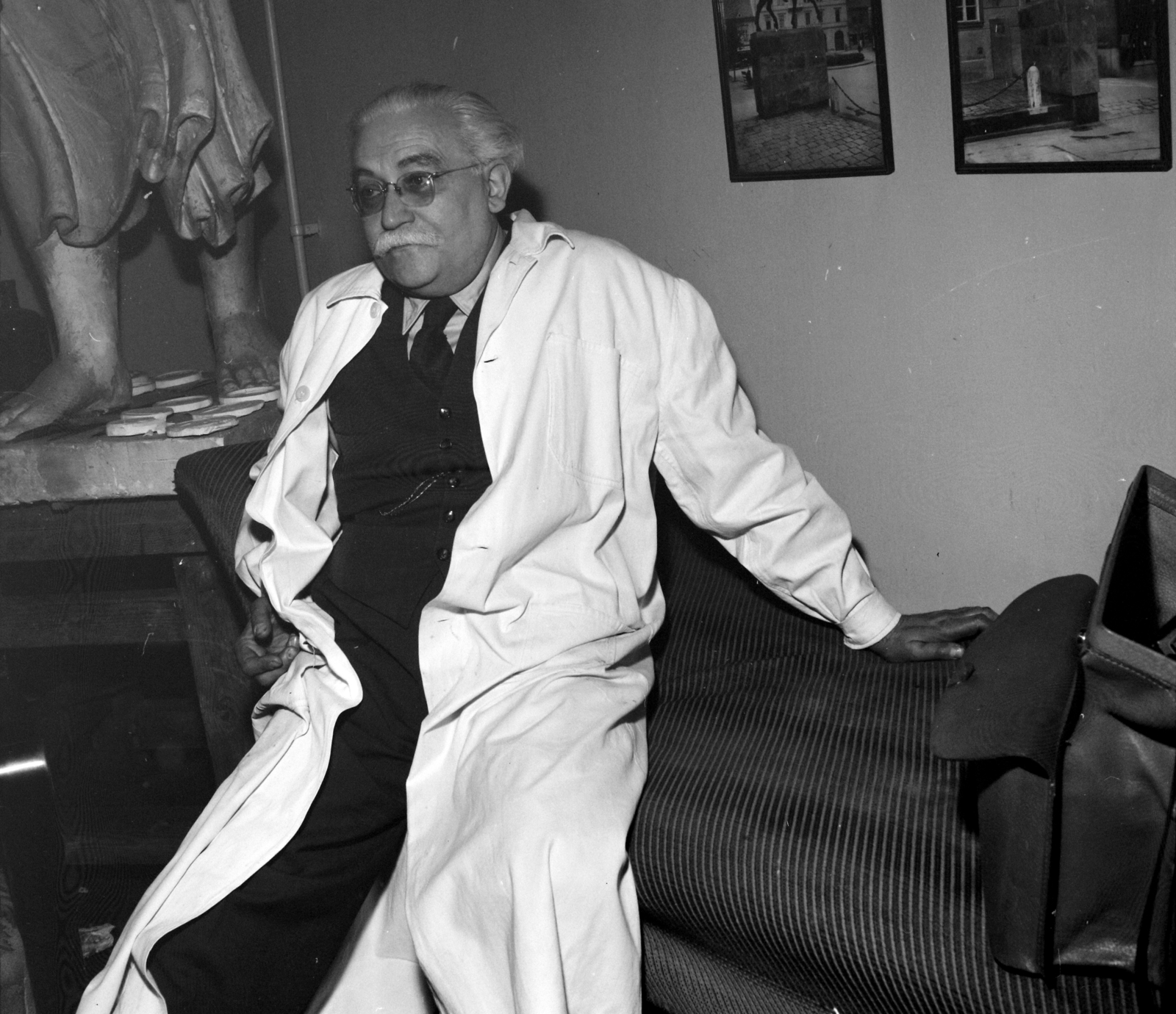
Sculptor Pál Pátzay in his studio in Epreskert in 1964 (Source: Fortepan / No.: 106817)
Yet he could have been mentioned in 1998, when he and his wife, Hertta Fuchs, posthumous received the Righteous Among the Nations honorific: in his studio in Kőbánya he hid persecuted people of Jewish origin, including his fellow sculptors, Fülöp Beck Ö. and Erzsébet Forgács Hann.
The obvious pathetic exaggerations in his official obituary, such as “the living classic of Hungarian sculpture” or “Pátzay’s art is self-contained perfection,” today only evoke a smile and are more detrimental to his judgement than useful. The ratings quoted are certainly due to the fact that Pátzay was one of the favourite creators of socialism. Among other things, he made the statue of Lenin, which once stood at Dózsa György Road in Felvonulási Square, which is now in the Memento Park, and he also portrayed János Kádár. But is Pátzay's art viable today?
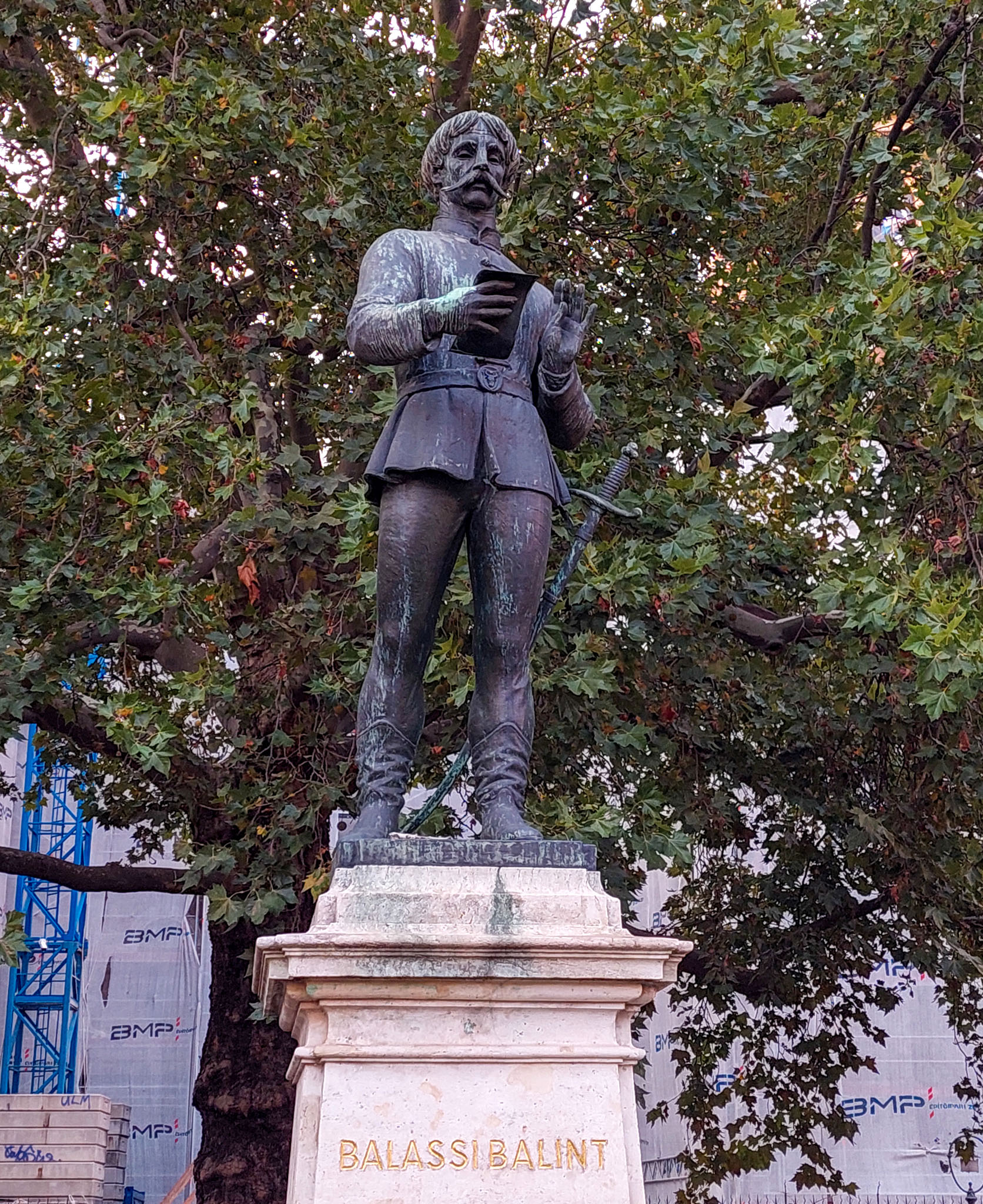 Statue of Bálint Balassi on the Kodály Körönd (Photo: Balázs Both / pestbuda.hu)
Statue of Bálint Balassi on the Kodály Körönd (Photo: Balázs Both / pestbuda.hu)
A comprehensive answer to this question remains to be seen, but two pre-World War II studies help provide a more nuanced approach. In 1930, István Genthon summarized Pátzay's artistic life in the columns of the journal entitled Magyar művészed, and Ervin Ybl did the same in the Szépművészet in 1942.
After the early expressionist bronze sculptures, Pátzay turned to portrait sculpture and, in the words of István Genthon, to “freely composed, monumental and static” sculptures: “you can feel the nervousness of change and development vibrating through this closed genre. Pátzay’s path led from dynamic art to increasingly static and these portrait sculptures seem to help smooth out the slow and consistent transformation. ”
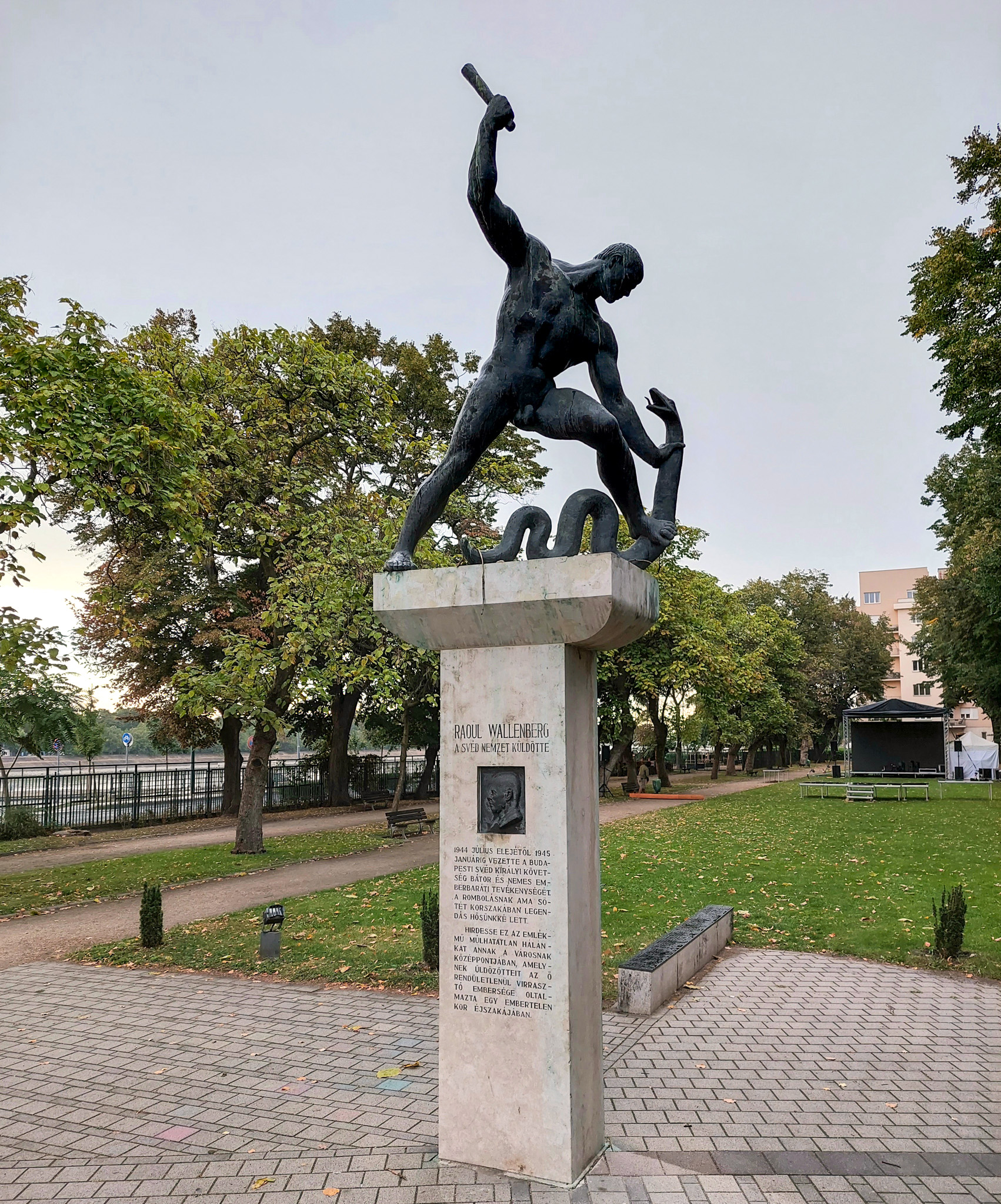 A copy of the Raoul Wallenberg monument has been adorning St. Stephen's Park since 1999 (Photo: Balázs Both / pestbuda.hu)
A copy of the Raoul Wallenberg monument has been adorning St. Stephen's Park since 1999 (Photo: Balázs Both / pestbuda.hu)
Both István Genthon and Ervin Ybl list the juvenile bronze statuette, made in 1919 and currently in MNG, entitled Fésülködő nő [Combing Woman] among Pátzay's most successful works. As Ervin Ybl writes, Pátzay “achieved a perfect result in the small bronze depicting the… Fésülködő nő. Pátzay likens the little nude sitting on a tree trunk, holding his hair high, to a sonnet. Every bit is permeated by life, the members of the body follow the movement of combing reflexively. The shapes are formed so rhythmically in the space, they form such a self-contained composition that the statuette really resembles a strict rhythmic scheme of a stanza ”.
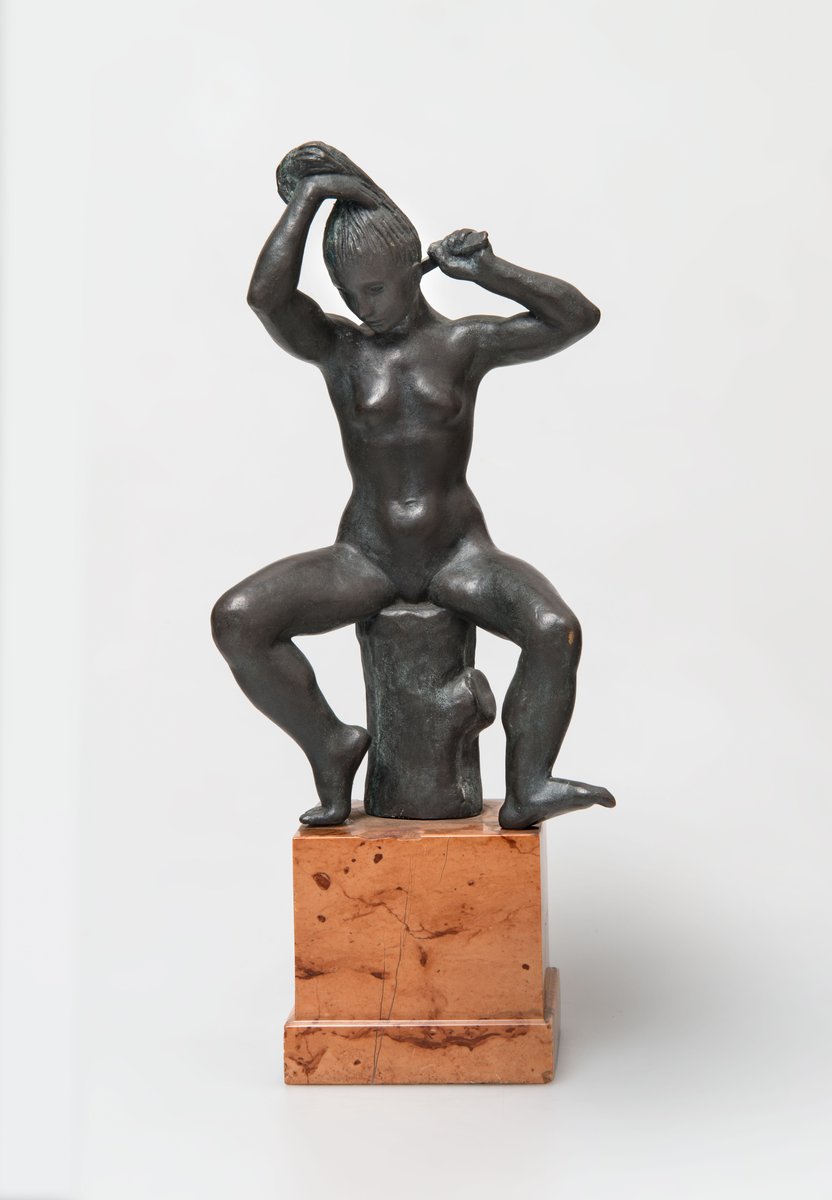
The small bronze entitled Fésülködő nő (Source: mng.hu)
According to Ervin Ybl, a stronger emotional expression and symbolism is not emphasized by Pál Pátzay, “only as much as the functioning of life determines in its everyday existence. … Their beauty, of course, is grasped only by those… who can still believe in the raison d’être of art for itself even after the fall of l’art pour l’art. No matter how much the path of art leads again to the expression of ideas and feelings that affect everyone equally,… the elite of sculptors and art connoisseurs will always appreciate such works of art. ”
István Genthon believed that Pátzay's unfolding art was initially even more individual, "as the art of youth usually is, it did not touch on the issue of general, large connections". One of the last works of this era was the Fésülködő Nő. As Genthon writes, the style of Pátzay’s early era “despite its dynamic nature and expansiveness, is intimate: it can only withstand smaller sizes. The last of them in time, the Fésülködő Nő, testifies to the turn to the new étappe. The small statuette is, so to speak, composed only for front and rear views, the abstract idea is evident from its silhouette drawing. The composition itself has a flawless rhythm, the limbs extending into space, harmoniously correspond to each other in the diagonal direction. The opposite movement was replaced by a more static idea, and passion gave way to a calm, rounding performance. ”
Ervin Ybl evaluates the 1931 limestone sculpture "covered in sheets" entitled Szomorúság [Sadness ] in MNG as “one of the most impressive sculptures” in the oeuvre. The shaping of a life-size female figure authentically presents a melancholic, resigned state of mind.
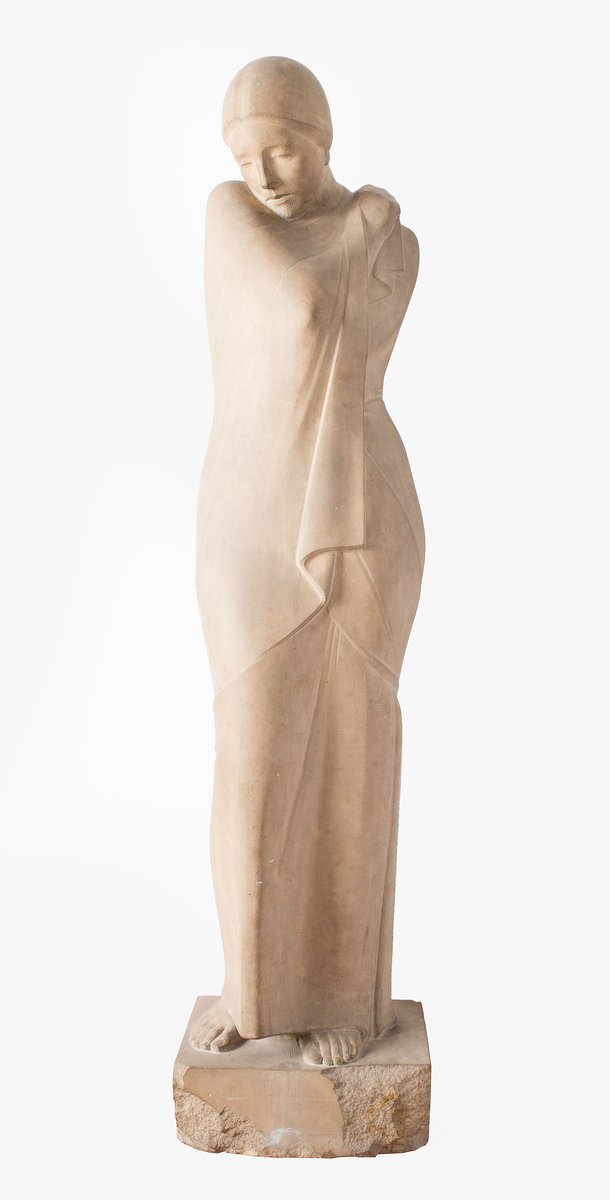
The limestone statue entitled Szomorúság is really expressive (Source: mng.hu)
In the case of the female figure, who presses her arms to her body, according to Ervin Ybl, “the formal idea is permeated by the softness of the antique beauty ideal, the tenderest tanagra statuettes. It was here that Pátzay came closest to the belief in the old classical forms and in this sculpture he emphasized the deepest spiritual expression. … The figure is completely covered by the tight robe and the scarf, the details and the flat-treated folds of clothes only play a secondary role in addition to the large forms. Yet the structure of the body prevails clearly under the sheets, the hips are tense, the right arm is protrudes under the scarf. A uniform, undulating mass is the figure, a novel revival of the old linea serpentinata. The melodically soft echo of the counter post, the bending in and out of the closed units gives the sculpture the appearance of spatial loneliness, and the sorrowful expression of the leaning, beautiful face adds even more to the sad expression of the figure. ”
After his study trip to Rome, Pál Pátzay, from the mid-1930s, as Ervin Ybl pointed out, “is mostly occupied with monumental tasks. In statuettes, he just tries out the solutions. ”
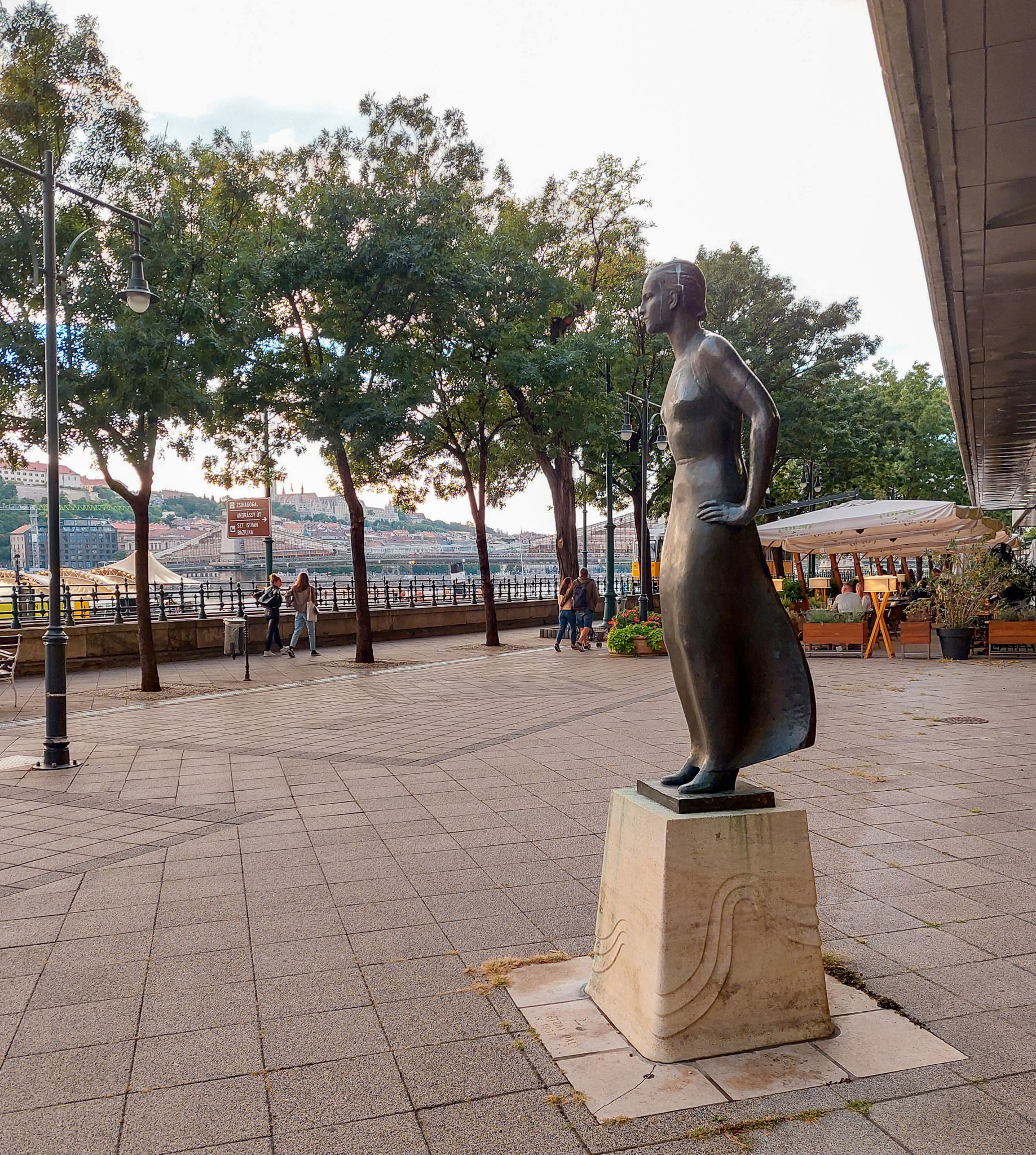 A copy of Pál Pátzay's work entitled Dunai szél has been on the Danube Promenade since 1994 (Photo: Balázs Both / pestbuda.hu)
A copy of Pál Pátzay's work entitled Dunai szél has been on the Danube Promenade since 1994 (Photo: Balázs Both / pestbuda.hu)
One of the most successful works of public sculptures is the Dunai szél [Danube Wind]. The figure of a young woman allegorizing Budapest, made in 1934, was once erected at the mouth of Türr István Street, in front of Hungária Nagyszálló , which was destroyed in World War II. Based on the original included in the MNG collection, the Budapest City Council commissioned a duplicate in 1994: this can be seen on the side of the InterContinental Hotel facing the Danube Promenade.
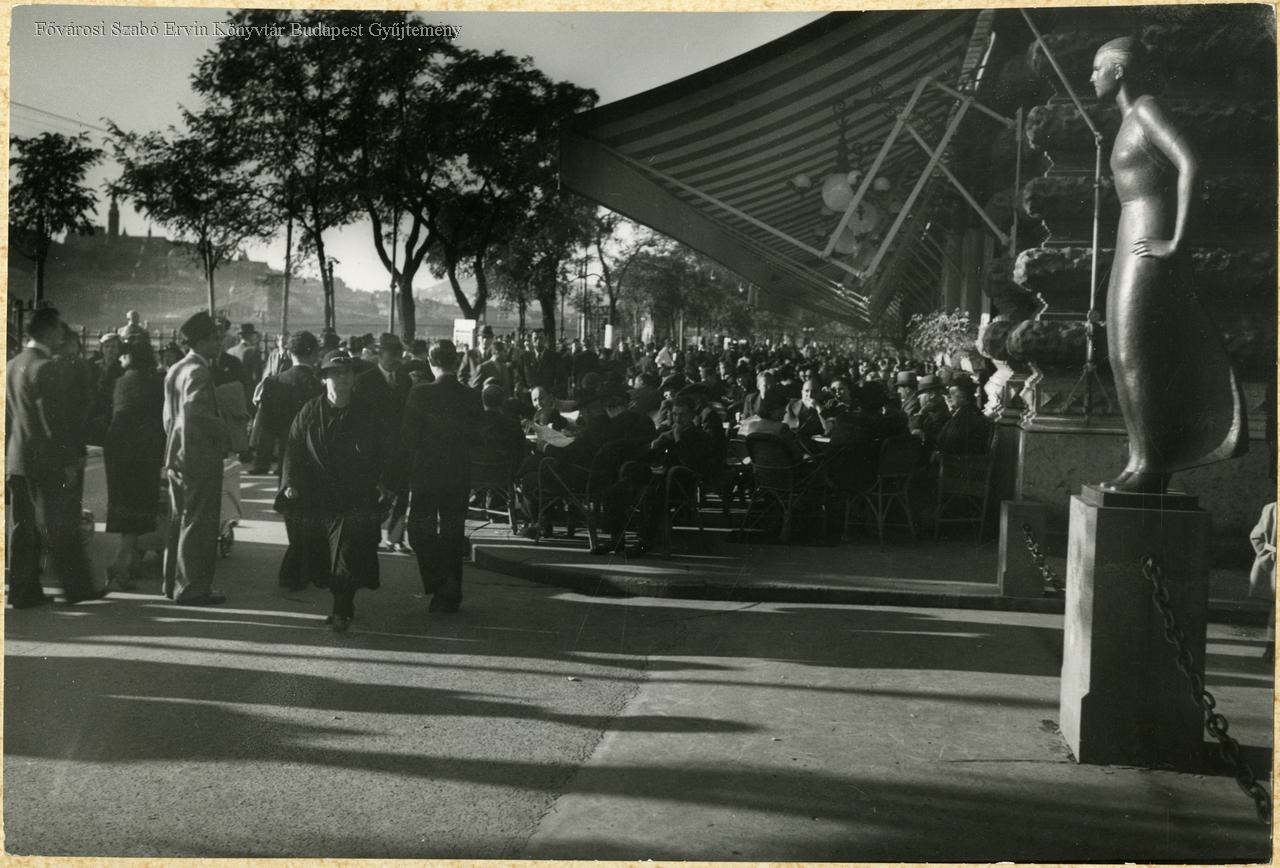 The original form of the lady of the Dunai szél was erected in 1937 in front of the Hungária Hotel, on the corner of Duna Promenade and Türr István Street (Source: FSZEK Budapest Collection)
The original form of the lady of the Dunai szél was erected in 1937 in front of the Hungária Hotel, on the corner of Duna Promenade and Türr István Street (Source: FSZEK Budapest Collection)
Standing on a square pedestal, masterfully composed in its anatomical proportions, the idealized young woman also shows the breath of the Danube breeze with her outfit that fits her body and her skirt fluttering backwards. Ervin Ybl also writes about the work "elegant but bound rhythm" under the title Budapest:
“On two legs, in high-heeled shoes, frontally stands a woman dressed in a fashionable dress, with her hands on her hips, she turns her smart, watching head slightly aside. Pátzay has undoubtedly made a concession in favour of elegance, his expression connecting the figure with direct life, but he says everything so concisely, only with the main forms, that despite the liveliness of the flexible slender lady, he rises to the abstract world of sculptural solution. ”
The graceful movement of the Dunai szél and the similarity of the clothes are echoed in the determined female figure of the Benedek Virág monument in Tabán. The statue, erected in 1971, stands in front of the former house of the Pauline poet, the first master of Hungarian ode poetry, at 10 Apród Street in the 1st District. The female figure holds in front of her a round relief depicting the poet.
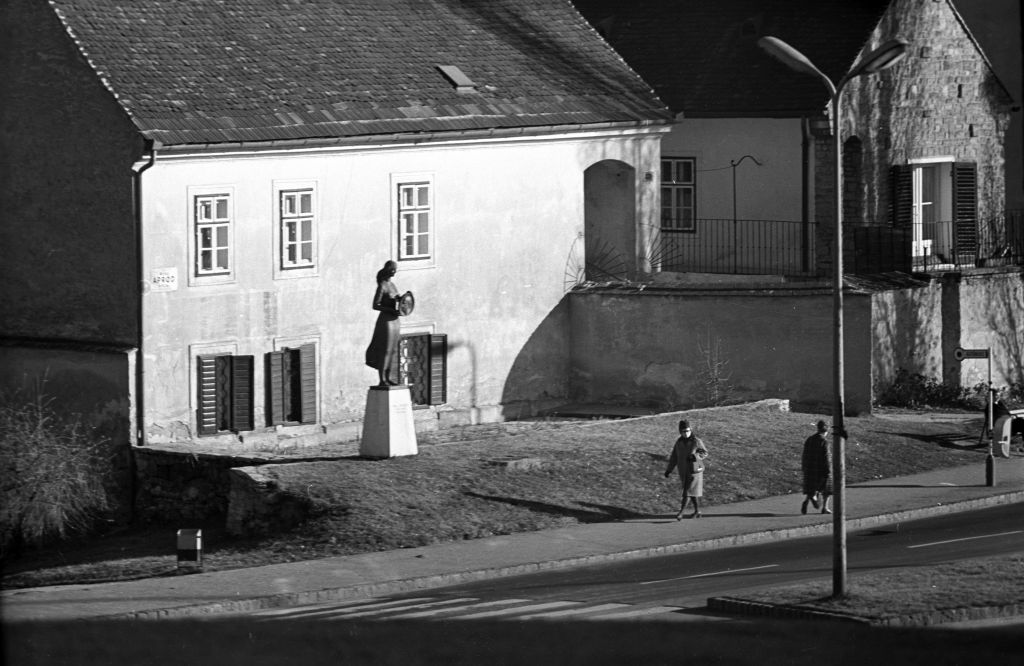 The statue commemorating Benedek Virág was erected in 1971 in Apród Street, in the 1st District, where it can still be seen today (Source: Fortepan / No.: 192047)
The statue commemorating Benedek Virág was erected in 1971 in Apród Street, in the 1st District, where it can still be seen today (Source: Fortepan / No.: 192047)
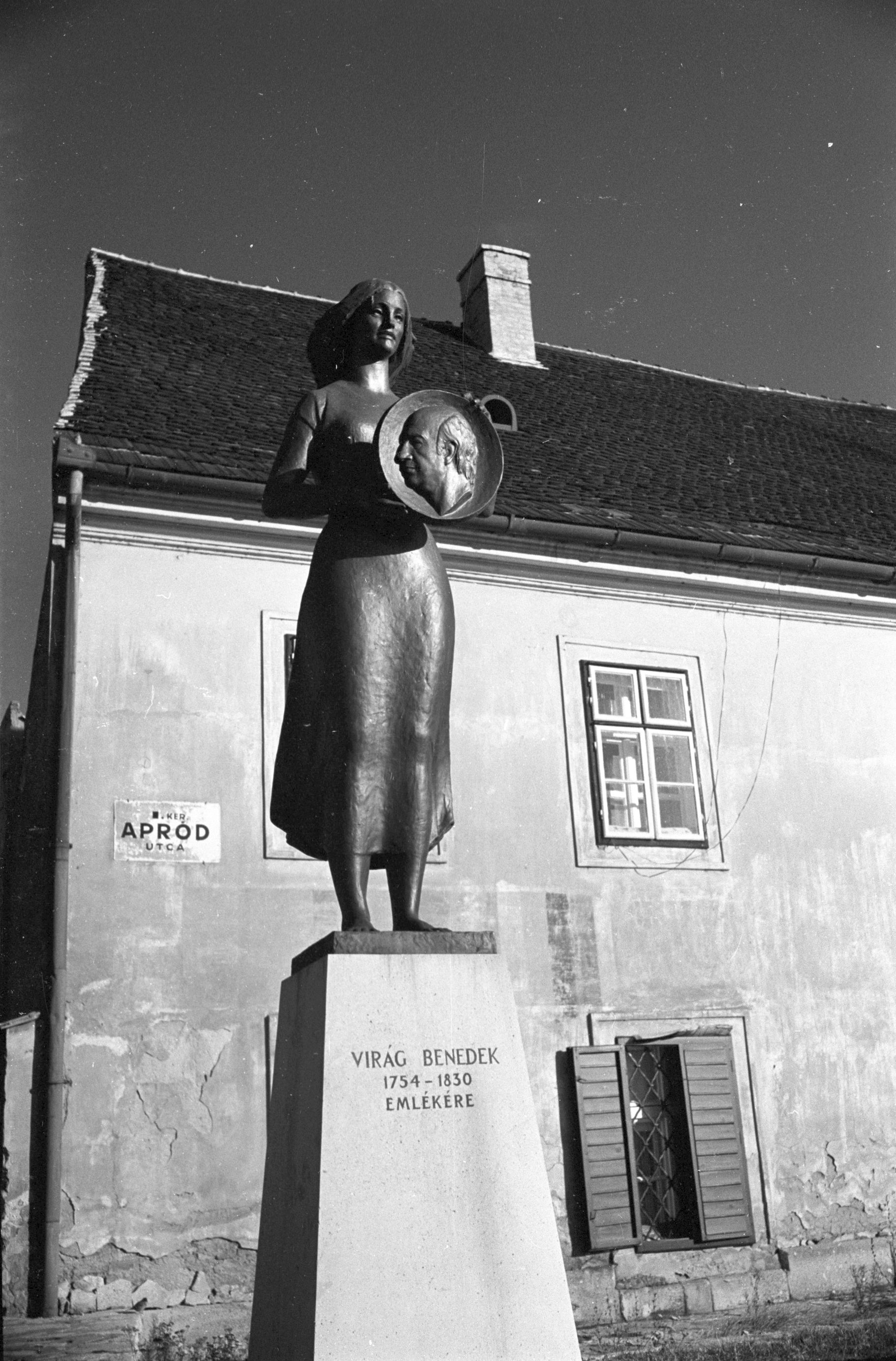 In Pátzay's work, the female figure holds a round relief depicting the poet (Source: Fortepan / No.: 192048)
In Pátzay's work, the female figure holds a round relief depicting the poet (Source: Fortepan / No.: 192048)
Pátzay was also a master of decorative sculpture: his featured works on the facade of the Opera House are full-length sculptures by Giuseppe Verdi and Charles Gounod, made in 1966. The allegories of sculpture, acting, painting, music and architecture on the façade of the Buda Castle and the Hungarian National Gallery are also the works of Pál Pátzay; they were made in 1969.
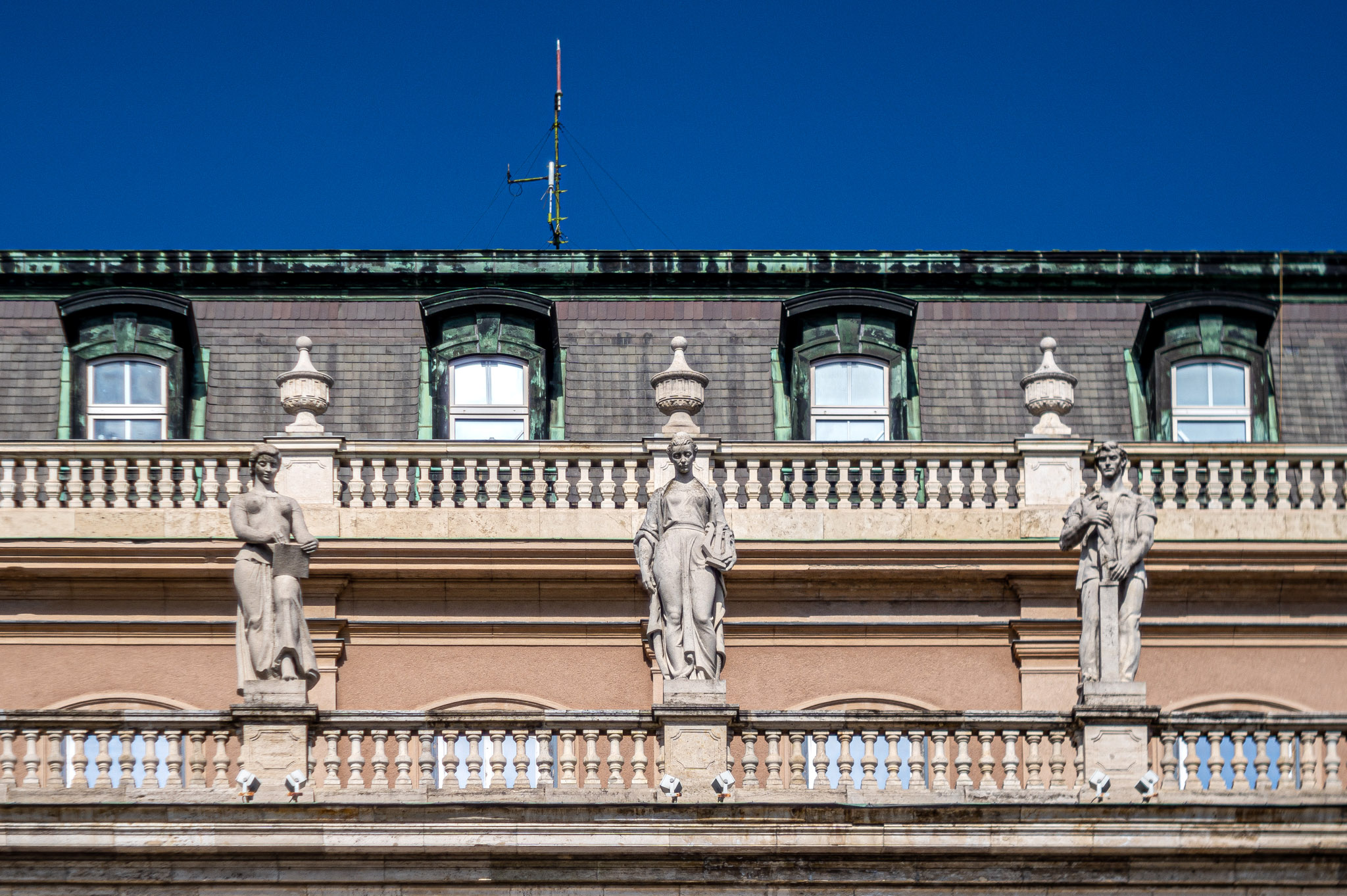 Excerpt from the allegorical sculptures on the facade of the Hungarian National Gallery (Photo: Balázs Both / pestbuda.hu)
Excerpt from the allegorical sculptures on the facade of the Hungarian National Gallery (Photo: Balázs Both / pestbuda.hu)
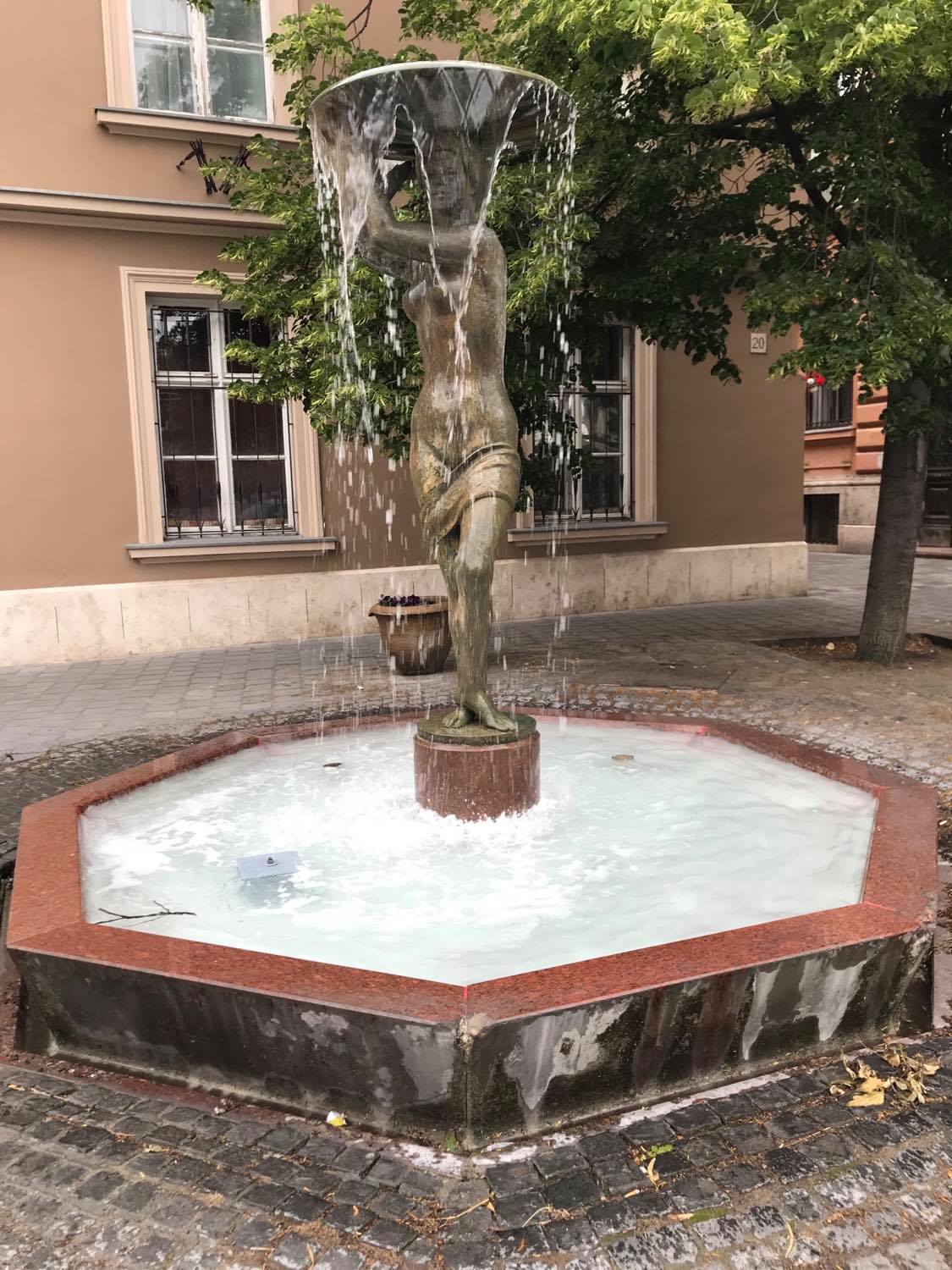 The sculpture entitled Vízjáték [Water Play], erected in 1975 with the help of József Schall, is still standing in the Buda Castle, Tárnok Street (Photo: pestbuda.hu)
The sculpture entitled Vízjáték [Water Play], erected in 1975 with the help of József Schall, is still standing in the Buda Castle, Tárnok Street (Photo: pestbuda.hu)
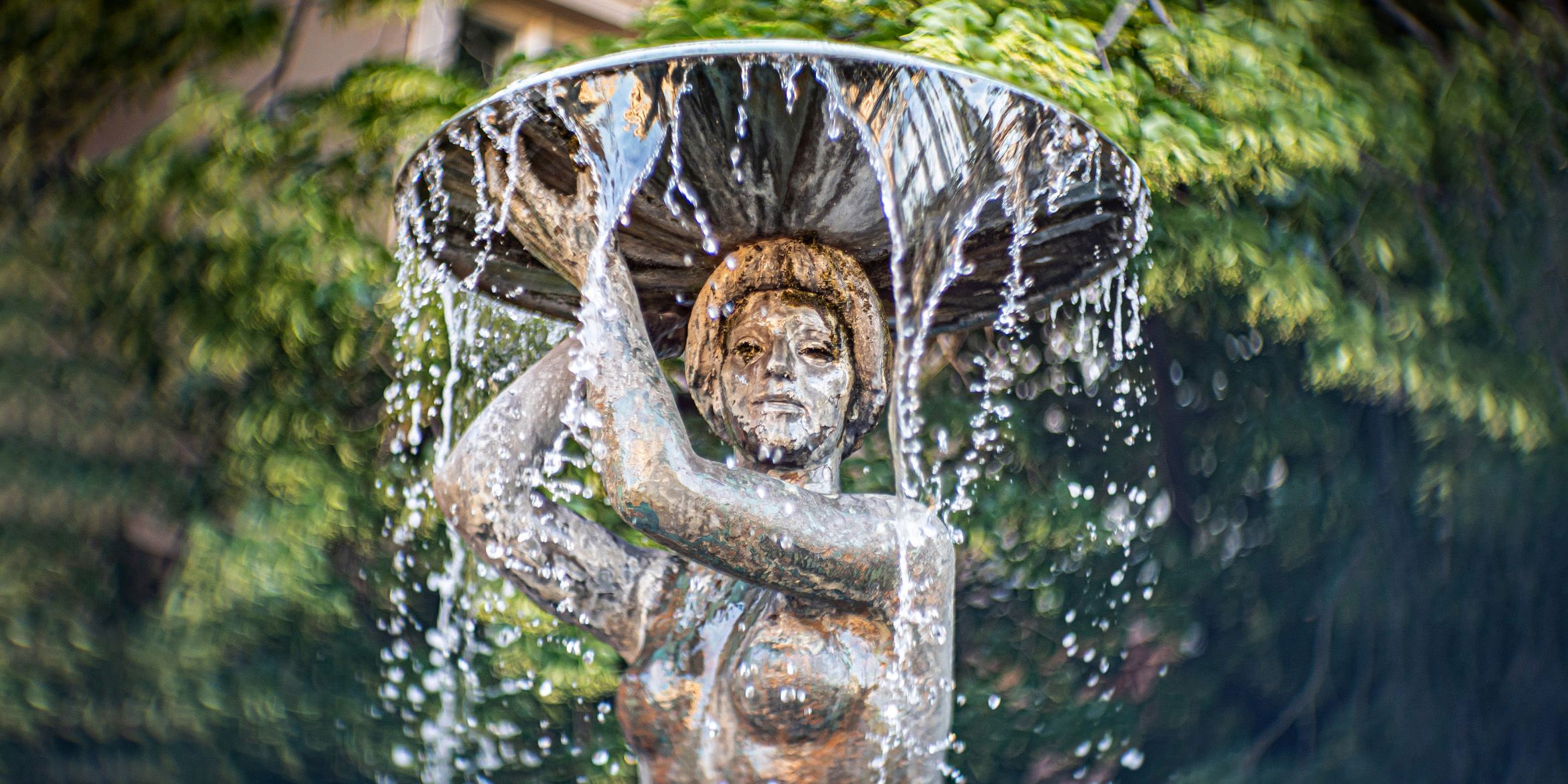 Part of the Vízjáték sculpture (Photo: Balázs Both / pestbuda.hu)
Part of the Vízjáték sculpture (Photo: Balázs Both / pestbuda.hu)
If we take a walk on Margaret Island, the busts of Mór Jókai (1975), Zoltán Kodály (1968) and Károly Lyka (1977) greet us in Pátzay's interpretation, but we also meet his work at the Zoo, the bust of János Xantus (1966).
The above examples also show that it would be worth rethinking the Pátzay value judgement so far and drawing the consequences in the light of a systematic, comprehensive analysis of the oeuvre: to determine what is permanent and what is not.
Cover Photo: A copy of the work entitled A Dunai szél on the Danube Promenade (Photo: Balázs Both / pestbuda.hu)


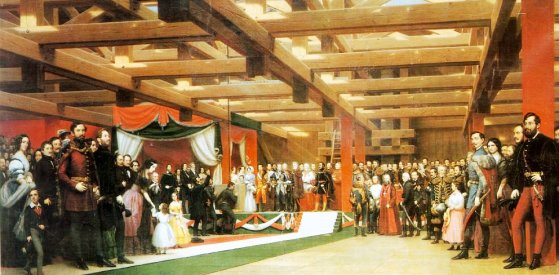
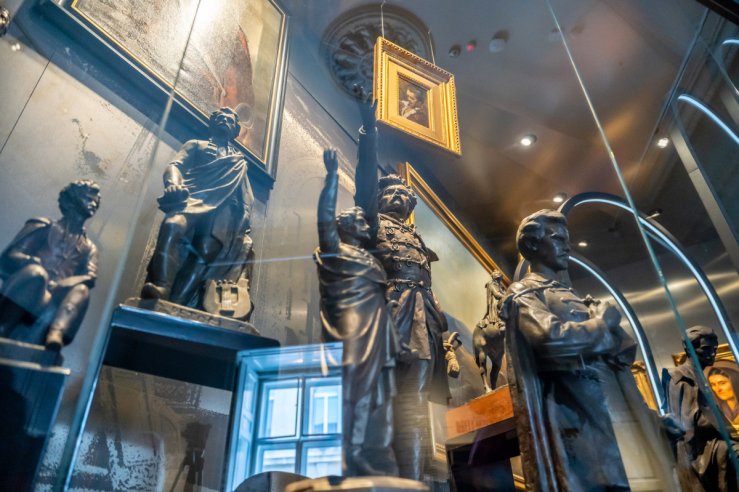
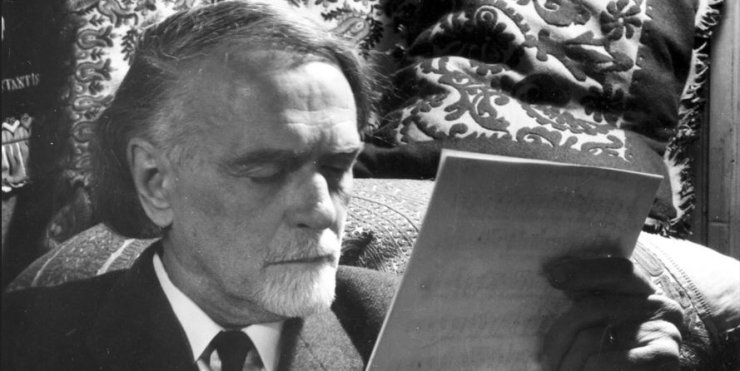

































Hozzászólások
Log in or register to comment!
Login Registration